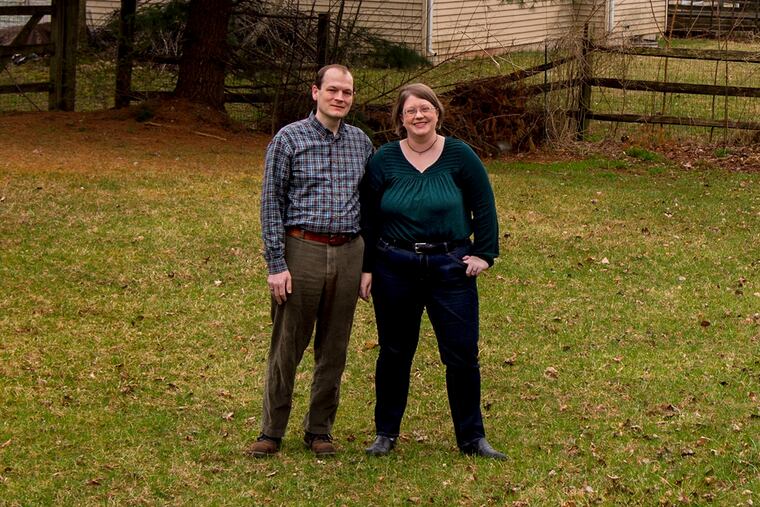They’re divorcing. They’re still good friends. How did the Weidners do it?
A new route for divorce — collaborative divorce — can dissolve a marriage in a year or less and can help eliminate the bitterness and cost of the process.

If only there were a way to divorce amicably, Stephanie and Seth Weidner wondered as they chose to end their marriage.
It turns out, there is.
After years of bitterness and tens of thousands of dollars, many divorcing couples watch helplessly as their cases languish in court.
Now a new way — collaborative divorce — can dissolve a marriage in a year or less and for as little as $10,000.
For that, and other deeply personal reasons, the Weidners chose collaborative divorce — and they’re among the first to talk about it publicly.
“We heard about it and realized it was a perfect fit for us. It’s such an amenable divorce. There were no disputes we couldn’t talk over. When we heard what this type of law was, we decided it was a good fit,” said Stephanie Weidner, a software engineer. “It took out some of the headaches, the normal things you hear about divorces.”
Seth agreed. “If you’re not hostile towards each other, this is a very good route to take,” he said.
Collaborative divorce works like this: All parties sign a “participation agreement,” the splitting spouses as well as attorneys and other professionals, including a mediator, financial adviser, or therapist.
Everyone meets together and all parties share information openly.
“It’s a totally different process, because regular divorce sets up the parties as adversaries — one lawyer and one client versus another. It was never set up to be cooperative in the courts,” said Kathy Bloom of Bloom Peters, the attorney representing Seth Weidner.
“Collaborative divorce throws that model out the window; we work together as a team. If the spouses can tolerate the other person, it’s so much better,” said Bloom.
She and Stephanie’s lawyer, Cathy Cardozo of Cardozo Family Law, can email, conference call, and meet directly with each other and the soon-to-be exes — everything’s communicated four ways.
“It’s not hidden. Nothing is secret. Everything’s out in the open,” Bloom said.
Why else choose collaborative divorce? Time and money. Litigated divorces can cost upward of $50,000 to $75,000 per person, while collaborative divorces range generally between $10,000 and $25,000 per person.
And collaborative divorce lawyers say the process reframes how they practice.
“I’ve done about 10 collaborative divorces over the years, but I’m finding because of the statute passed [in 2018], it’s become more legitimate,” said Cardozo. “Plus I’m not going into court like a bulldog. Instead, I’m advocating to work things out.”
The new law she’s referring to is the Pennsylvania Collaborative Law Act, part of House Bill 1644 sponsored by State Rep. Kate Klunk (R., York), signed by Gov. Tom Wolf in 2018. The law created a uniform standard of practice in Pennsylvania for collaborative divorces.
What about the Weidner children, who are still teenagers?
“Our kids took it well, because the marriage has been on a decline for five years into friendship. The thing that made it a marriage is gone. They weren’t surprised,” said Stephanie, 42, and a Lansdale resident. “My daughter’s 18, she knows all about the process and she likes it."
Bad blood didn’t exist between the couple. Seth moved out but remains close by, and Stephanie and the children remain in the family home with their five cats.
So collaborative divorce worked for them — though they know it doesn’t work for everyone.
“To do collaborative divorce, you have to be honest. You have to lay out all your accounts, and if you’re hiding money, or intentionally withholding amounts, someone will find out, and there will be hell to pay!” Stephanie said. “And you also have to be willing to split things evenly and be civil. Hurting the other person doesn’t work.”
Friends of the Weidners who tried collaborative divorce are not progressing, Stephanie said, because “one party is attempting to get 60 percent [of assets] instead of 50 percent, and also to get full custody.”
“This fit the mind-set Stephanie and I had going in,” said Seth, 43. He and Bloom, and Stephanie and Cordoza, have met several times together to hash out details. Their divorce will likely take under one year to be finalized.
“"I’m not out to get her, and she’s not out to get me. We don’t want each other to suffer," Seth said. "We came to the end of a beautiful marriage, and we were better suited to being friends than to living together. And the collaborative law approach, we find to be a good way to achieve that goal.
“It does help that we’re very amicable," he admitted. "You can’t really go forward without that.”
In cases where collaborative divorces don’t go through, the lawyers and professionals withdraw, and the divorcing parties must pick new lawyers. That way, none of the information shared earlier becomes courtroom fodder.
With collaborative divorce, said Bloom, it’s important to choose licensed professionals such as those with ties to a state bar association, licensed social workers, and licensed marriage and family therapists, as well as CPAs and CDFAs, or Certified Divorce Financial Analysts.
What would the Weidners want people to know about their collaborative divorce?
“There’s a stigma around divorce that it’s an angry, long, expensive ordeal. And as long as you’re willing to be honest, and open to communication and compromise," said Stephanie, "this is a wonderful way to have a good, short, and relatively cheap experience.”
To get started researching collaborative divorce, visit the website: GoCollaborativePa.com.